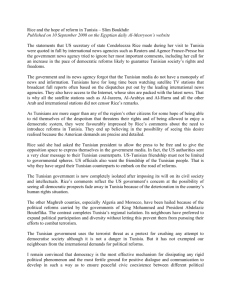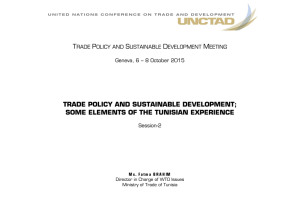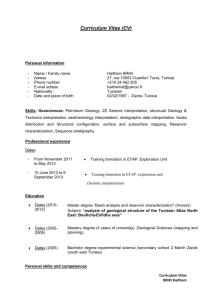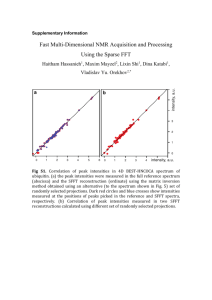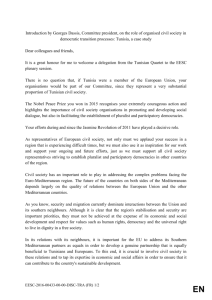Research Journal of Applied Sciences, Engineering and Technology 8(7): 850-855,... ISSN: 2040-7459; e-ISSN: 2040-7467
advertisement
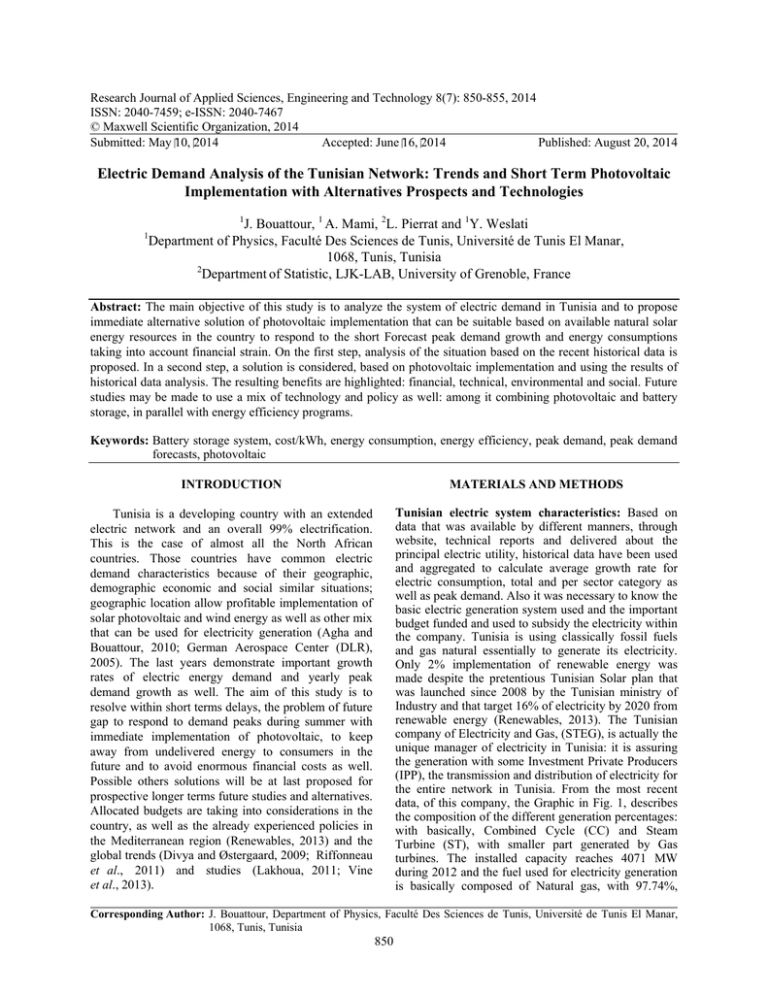
Research Journal of Applied Sciences, Engineering and Technology 8(7): 850-855, 2014 ISSN: 2040-7459; e-ISSN: 2040-7467 © Maxwell Scientific Organization, 2014 Submitted: May 10, 2014 Accepted: June 16, 2014 Published: August 20, 2014 Electric Demand Analysis of the Tunisian Network: Trends and Short Term Photovoltaic Implementation with Alternatives Prospects and Technologies 1 J. Bouattour, 1 A. Mami, 2L. Pierrat and 1Y. Weslati Department of Physics, Faculté Des Sciences de Tunis, Université de Tunis El Manar, 1068, Tunis, Tunisia 2 Department of Statistic, LJK-LAB, University of Grenoble, France 1 Abstract: The main objective of this study is to analyze the system of electric demand in Tunisia and to propose immediate alternative solution of photovoltaic implementation that can be suitable based on available natural solar energy resources in the country to respond to the short Forecast peak demand growth and energy consumptions taking into account financial strain. On the first step, analysis of the situation based on the recent historical data is proposed. In a second step, a solution is considered, based on photovoltaic implementation and using the results of historical data analysis. The resulting benefits are highlighted: financial, technical, environmental and social. Future studies may be made to use a mix of technology and policy as well: among it combining photovoltaic and battery storage, in parallel with energy efficiency programs. Keywords: Battery storage system, cost/kWh, energy consumption, energy efficiency, peak demand, peak demand forecasts, photovoltaic INTRODUCTION MATERIALS AND METHODS Tunisia is a developing country with an extended electric network and an overall 99% electrification. This is the case of almost all the North African countries. Those countries have common electric demand characteristics because of their geographic, demographic economic and social similar situations; geographic location allow profitable implementation of solar photovoltaic and wind energy as well as other mix that can be used for electricity generation (Agha and Bouattour, 2010; German Aerospace Center (DLR), 2005). The last years demonstrate important growth rates of electric energy demand and yearly peak demand growth as well. The aim of this study is to resolve within short terms delays, the problem of future gap to respond to demand peaks during summer with immediate implementation of photovoltaic, to keep away from undelivered energy to consumers in the future and to avoid enormous financial costs as well. Possible others solutions will be at last proposed for prospective longer terms future studies and alternatives. Allocated budgets are taking into considerations in the country, as well as the already experienced policies in the Mediterranean region (Renewables, 2013) and the global trends (Divya and Østergaard, 2009; Riffonneau et al., 2011) and studies (Lakhoua, 2011; Vine et al., 2013). Tunisian electric system characteristics: Based on data that was available by different manners, through website, technical reports and delivered about the principal electric utility, historical data have been used and aggregated to calculate average growth rate for electric consumption, total and per sector category as well as peak demand. Also it was necessary to know the basic electric generation system used and the important budget funded and used to subsidy the electricity within the company. Tunisia is using classically fossil fuels and gas natural essentially to generate its electricity. Only 2% implementation of renewable energy was made despite the pretentious Tunisian Solar plan that was launched since 2008 by the Tunisian ministry of Industry and that target 16% of electricity by 2020 from renewable energy (Renewables, 2013). The Tunisian company of Electricity and Gas, (STEG), is actually the unique manager of electricity in Tunisia: it is assuring the generation with some Investment Private Producers (IPP), the transmission and distribution of electricity for the entire network in Tunisia. From the most recent data, of this company, the Graphic in Fig. 1, describes the composition of the different generation percentages: with basically, Combined Cycle (CC) and Steam Turbine (ST), with smaller part generated by Gas turbines. The installed capacity reaches 4071 MW during 2012 and the fuel used for electricity generation is basically composed of Natural gas, with 97.74%, Corresponding Author: J. Bouattour, Department of Physics, Faculté Des Sciences de Tunis, Université de Tunis El Manar, 1068, Tunis, Tunisia 850 Res. J. Appl. Sci. Eng. Technol., 8(7): 850-855, 2014 Tunisian Generation System 2011 Data Investments of Private Producers 19% Renewable Energy 2% Combined Cycle 33% Gas Turbine 14% Steam Turbine 32% Fig. 1: Tunisian utility generation categories Tunisian Energy Consumption repartition per sectors 2009 Tunisian electric production in Gwh 2008-2012 16781 14149 13757 14889 15220 6% Agriculture 19% 39% Services Residential Industrial 2009 2008 2010 2011 36% 2012 Fig. 2: Tunisian electric system generation Fig. 4: Tunisian energy consumption percentage per sector Agriculture Services Average growth 12.00 40.00 10.00 35.00 8.00 30.00 Percentage 25.00 20.00 15.00 10.00 6.00 4.00 2.00 To tal ust ria l l tia den ce rvi -4.00 2009 Ind 2007 2006 2005 2008 Tunisian energy consumption per sectors percentages Growth rate 2004-2009 Re si 2004 Se 0.00 cu l -0.00 tur e 0.00 5.00 Ag ri Growth rates (%) 45.00 Residential Industrial Fig. 5: Tunisian energy consumption average growth rates Fig. 3: Tunisian energy consumption growth rates per sectors Peaks demand growth: Maximum real power demand is sketched for each month, during last years in Fig. 6 showing the important power demand during summer seasons, which is related to temperature growth as well as the important peak growth versus years (Bouchoucha et al., 2013). Figure 7 is precisely the percentage growth for each month and this will allow sketching the growth forecast for at least short term scenario. July and August, but also September and October headline the significant growth of peak demand. This is obviously 2.23% of Renewable Energy (RE) and 0.03% of Gas Oil, (STEG data). The evolution of electricity produced versus years is also presented in Fig. 2. The data regarding energy consumption are also considered: Figure 3 to 5 shows the energy consumption versus sector repartition, its growth and its average per sector. It is obvious that Industrial and residential sectors are preponderant in electric consumption. But residential sector consumption is growing much faster. 851 2008 2009 3500 3300 3100 2900 2700 2500 2300 2100 1900 1700 1500 2011 2012 6000 2010 2014 2015 2016 2020 2018 2019 5721 MW 5000 5005 4500 4380 4000 3500 3832 3000 2500 Fig. 8: Tunisian monthly maximum demand forecasts Average growth per month 7.00 6.00 5.00 GWh 4.00 3.00 1.00 Jun e Jul y Au g S ep ust te m ber Oc tob er No vem b er De cem ber 0.00 Fe b ru ary Ma rch Ap ril Ma y 20000 18000 16000 14000 12000 10000 Total energy consumption forecasts Peak forecasts 17876 17172 15846 16496 15222 14623 18609 8000 6000 4000 2000 0 2.00 ary Au g Sep ust te m b er Oc to b er No vem b er De cem b er Tunisian Monthly peak demand for forcasts based on historical average growths 2014-2020 Fig. 6: Tunisian monthly maximum electric demand Jan u Jun e Jul y Jan u ar Feb y rua ry Ma r ch Ap ril Ma y Jun e Jul y Au gus Se t p te mb er Oc tob er No v em b er De cem ber 2000 Tunisian monthly maximum electric demand in MW 2008-2012 Percentage (%) 2017 5500 Jan uar Fe b y rua ry Ma rch Ap r il Ma y MW Res. J. Appl. Sci. Eng. Technol., 8(7): 850-855, 2014 2014 Tunisian average growths for maximum demand per month 2008-2012 2015 2016 2017 2018 2019 2020 Tunisian electric energy consumption Short term forecasts 2012-2020 Fig. 9: Tunisian electric energy consumption forecasts Fig. 7: Tunisian maximum monthly demand average growth rate MWh consumption during peaks equal 634676.5 at the unit cost of production of 4.5 Tunisian Dinars (TND) per kWh, which is the equivalent of US $ 2.81/kWh. The equivalent cost of 2012 peaks corresponds to a total 2856044250 Tunisian Dinars, equivalent to US$ 1,785,040,000. directly related to the air conditioning use happening simultaneously when Temperatures increase. Forecast considerations: Taking into account the recently registered peak growth, for the immediate short term forecasts, it is obvious that the situation of the actual Tunisian network need an immediate solution to remediate to the peaks increase and respond to the actual demand growth. Figure 8 highlights the reality that will take place as soon. The increase of more than 200 MW/year in peak demand is demonstrated through the average growth rates calculated based on historical data. The risk of blackouts and failure is big within such situation: financial as well as technical issues should be considered. Energy consumption short term forecasts: Energy forecasts will be used to precise the situation for the total energy consumption on short terms scenario; the average growth rate find through historical data of energy consumption growth 2004-2009 will be used for this goal. Also, based on the approximate percentage of energy consumption during summer peaks percentage versus the total energy consumption per year calculated during 2012 which corresponds to almost 5%, the assessment for energy consumption per summer peak is calculated on short forecast views. Figure 9 sketches the short term forecasts of energy consumption per year and the energy consumption to satisfy energy peak The summer peaks issues: It will be referred to registered peaks during 2012 summer: the cumulated 852 Res. J. Appl. Sci. Eng. Technol., 8(7): 850-855, 2014 Yearly energy consumption may be considered, with the corresponding capacity implementation that can be attributed. Also, only energy implied by summer peak demand can be calculated with the accredited capacity to be implemented consequently. A mix of solution can also be managed to fulfill the different immediate necessary energy demand on the Tunisian network, to avoid drastic and expensive demand peaks, such as those above indicated. PV capacity to produce total yearly energy consumption in Tunisia (MW) 500 MW photovoltaic 400 320 333 347 361 376 391 407 300 200 100 Photovoltaic immediate implementation: Taking into consideration the last energy consumption registered into 2013, that will be assumed as satisfied entirely by installed capacity till the date, the necessary consumption to be satisfied for immediate next years with new implemented capacity will be assumed as equal to the following: ‘Forecasts Energy-Energy satisfied in 2013’. Assuming the energy produced per year per 1 kWc photovoltaic unit, corresponding to the average 1800 kWh/year (DLR Study), the photovoltaic to be implemented to satisfy the short term need in Tunisia will be easily calculated, as sketched in Fig. 10. In the other hand, the repartition of energy delivered to the network versus months and the delivered per unit PV capacity versus months, will be taking into account, to highlight the opportunity of PV to respond specifically to the huge energy consumption during summer; the Fig. 11 shows the compatibility between energy delivered from the PV production and the repartition of energy consumed in percentage versus months. The graphics show easily that implementing PV is very opportune to respond to the summer peaks specifically because PV production units are the most efficient during summer seasons. 0 2014 2015 2016 2017 2018 2019 2020 Fig. 10: Photovoltaic implementation for short forecasts energy demand Percentage (%) 15.00 2012 repartition Energy repartition of PV versus month 10.00 5.00 Jun e Jul y Au gus Se p te t mb er Oc to b e r No v em b e De r cem ber Jan uar y Fe bru ary Ma r ch Ap ril Ma y 0.00 The repartition tunisia energy delivered to the network 2012 per months Fig. 11: Compatibility between energy delivered by photovoltaic system and energy delivered ob Tunisian utility system versus months Photo Voltaic (PV) implementation for summer energy peak demand: Table 1 includes calculations that have been made for the implementation needed to respond to energy implied by summer peaks for short term considerations. It was assumed based on the 33% of total energy that PV panel deliver during summer demand during summer. Based on all data, possible solutions will be presented through immediate photovoltaic implementation; later on, battery storage solution, energy efficiency can be considered from different angles within future studies. Table 1: Capacity implementation need for summer peaks in Tunisia PV implementation forecasts for peats summer energy -----------------------------------------------------------------------------------------------------------------------------------------------Year 2014 2015 2016 2017 2018 2019 2020 Peaks energy (GWh) 687.79 715.98 745.34 775.90 807.71 840.83 875.30 Lacks (GWh) 687.79 28.20 29.35 30.56 31.81 33.12 34.47 PV yearly GWh 2084200384 85451052 88954498 92601583 96398196 1E+08 104464781 PV (kwc) 1102168 45188 47041 48970 50977 53067 55243 PV MWc 1102 45 47 49 51 53 55 Table 2: Photovoltaic implementation repartition by sector PV implementation repartition by sectors -----------------------------------------------------------------------------------------------------------------------------------------------Year 2014 2015 2016 2017 2018 2019 2020 Total MWc 1102 45 47 49 51 53 55 39% ind 430 18 18 19 20 21 22 36% resid 397 16 17 18 18 19 20 19% service 209 9 9 9 10 10 10 6% agricul 66 3 3 3 3 3 3 853 Res. J. Appl. Sci. Eng. Technol., 8(7): 850-855, 2014 months (specifically June, July and August are considered as specific months of maximum peak demands per year); this means that peaks energy are considered as 33% of the total panel production that should be installed. From the yearly GWh that will be delivered by the PV, calculation is made to find the PV capacity that can respond to the energy peak (1 kWc is equivalent to yearly 1800 kWh). Table 2 shows the repartition of adequate PV implementation based on consumption percentage per sector and per year. Introduction BESS to smooth the peak (2010 Tunisian maximum peak demand in MW) Power demand (MW) 3500 RESULTS AND DISCUSSION • • 3000 2500 2000 1500 1000 BESS charging 500 BESS discharging 0 -500 The Tunisian Electric system is suffering from different gaps below enumerated: • • Max 2010 300BESS Reduce demand peak 1 3 5 7 9 11 13 15 Hours 17 19 21 23 Fig. 12: Prospecting the impacts of battery storage system to reduce the peaks Important growth of peak demand Huge budget related of back up (2856044250 TND in 2012 equivalent to US $ 1778912866). In 2013, the STEG was obliged to rent some gas Turbine Generators (TAG) to remediate against important gaps for the power demand; as well the STEG have to stop delivering power for certain parts of network (Bouchoucha et al., 2013) Preponderant dependence on fossil fuels Important government budget allocation of 500 Milliards of Tunisian Millimes (US$ 3.1143E+8) per year (Declaration of the head of STEG, during a technical day on 6 March 2014) may resolve the gap. From the other hand and based on the cost of peak during 2012, it is easily demonstrated that such budget could be managed for the equivalent 902 MWc PV implementation as below presented: 3 * 2856044250 = 902 MWc (9500 * 1000) The significance is that the allocated budget of 2012 to the peaks uniquely would be a sufficient to implement a preponderant need to resolve the peaks for the future years. It is also known that since 2010, similar peaks have cost 4 TND/kWh. The calculated implementation of Photovoltaic system in Tunisia is equivalent to 9500 TND per PV system of 3 kWc free of taxes, based on reference costs obtained by local supplier of PV system. The Table 3 summarizes the cost based considerations in comparison with the already suffered back up budget as well. It should be noticed that cost of PV did not consider the plausible decrease of cost per unit taking into consideration the scale up implementation criteria known also as mass production criteria. The Table 3, gives the cost of implementation in TD and in equivalent US$, from 2014 till 2020. A comparison is made with the 500 Milliards of TND allocated yearly as budget subsidies to the STEG; The Table 3 demonstrates that for 2014, just 70% of the budget may be allocated to the PV implementation; the next implementations percentage will be very low; this means that using this budget on the first peaks demand Other possible mix of solutions: PV is one solution that is directly related to the country natural resources. But it is not the unique one. Combining PV, or wind (Gergaud, 2002) with storage system and in particular battery system may be used also with its different possible benefits. Some have been used, analyzed and demonstrated through different studies (Bouattour and Pierrat, 2014). Storage associated to PV, may be used for Load leveling, back up securing system against black out as distributed system within substations. Tunisian is a country rich with its solar resources and it has to optimize with the accessible technology. Using battery storage in complementarities with photovoltaic, or hybrid system, (Kathirvel and Porkumaran, 2014) will imply the advantage to flat the demand load, using MWh of charging during off peak costs and discharging Table 3: Photovoltaic implementation costs versus Tunisian present budget allocation PV cost of implementation -------------------------------------------------------------------------------------------------------------------------------------------------Year 2014 2015 2016 2017 2018 2019 2020 Total MWc 1102 45 47 49 51 53 55 Cost impl (DT) 3490199832 1.43E+08 1.49E+08 1.55E+08 1.61E+08 1.68E+08 174936616 Cost impl (US$) 2173902377 89128784 92783014 96587066 100547082 104669456 108960846 Budget AIIo 0.70% 0.03% 0.03% 0.03% 0.03% 0.03% 0.03% 854 Res. J. Appl. Sci. Eng. Technol., 8(7): 850-855, 2014 Bouchoucha, C., H. Ben and J. Emma, 2013. Passages de l’ete 2013, contraintes et solutions. J. ‘L’energie, 86: 26-33. Divya, K.C. and J. Østergaard, 2009. Battery energy storage technology for power systems: An overview. Electr. Pow. Syst. Res., 79: 511-520. Gergaud, O., 2002. Energetic Modelisation and economic optimisation of wind and photovoltaic production grid connected system associated to accumulator. Thesis, Ecole Normale Supérieure de Cachan, France. German Aerospace Center (DLR), 2005. DLR Study: Concentrating Solar Power for the Mediterranean Region. Study Commissioned by Federal Ministry for the Environment, Nature Conservation and Nuclear Safety, Germany. IEA (International Energy Agency), 2011. 25 Energy Efficiency Policy Recommendations. 2011 Update, France. Kathirvel, C. and K. Porkumaran, 2014. Optimization of performance characteristics of hybrid wind photovoltaic system with battery storage. Res. J. Appl. Sci. Eng. Technol., 7(12): 2452-2462. Lakhoua, M.N., 2011. Systemic analysis of a wind power station in Tunisia. J. Electr. Electron. Eng., 4(1). Office of US Technology Assessment, 1993. Energy Efficiency: Challenges and Opportunities for Electric Utilities September Office of Technology Assessment. US Congress, Washington, DC. Renewables, 2013. Renewable Energy Policy Network for the 21th Century. Global Status Report. Retrieved on: http://www.ren21.net/. Riffonneau, Y., S. Bacha, F. Barruel and S. Ploix, 2011. Optimal power flow management for grid connected PV systems with batteries. IEEE T. Sustain. Energ., 2(3): 309-320. Vine, D., L. Buys and P. Morris, 2013. The effectiveness of energy feedback for conservation and peak demand: A literature review. Open J. Energ. Efficien., 2: 7-15. storage system at peak as demonstrated by the Fig. 12. Also, inciting consumer to reduce their consumption can be implied simultaneously when STEG will stop the subsidies of electricity mainly for big consumers and reduce the cost of kWh consumption during off peak times. Moreover, applying real energy efficiency policy: may reduce efficiently the electric consumption as part of important energy consumption; according to IEA (2011), the reduction by 17% of the current annual worldwide energy consumption, is possible if energy efficiency recommendations are immediately applied and based on Office of US Technology Assessment (1993) increasing the efficiency of energy through programs and policies use by consumers to compensate demand growth can be a economically good and reliable option to the addition of new generating plants. Tapping the economic and technical resources of electric utilities can be a successful strategy to speed the implementation of energy-efficient technology in all sectors, with costs saving results; in US, the department of energy evaluate a saving of 20% of national energy by 2020, if energy efficiency is applied (Bob, 2007). All combined solutions can be valuable against the gap of the electric Tunisian system, next to environmental and social impacts of CO 2 emission reduction and employment creation. Those solutions should be treated in details within future studies. REFERENCES Agha, K. and J. Bouattour, 2010. Harnessing Solar Energy Potential of the Sahara Desert and Sahel Region for Electricity Generation. AFREC, Addis Abeba. Bob, F., 2007. Energy Efficiency in the Power Grid. ABB Inc., US. Bouattour, J. and L. Pierrat, 2014. Energy storage system benefit in the electric power utilities of the Gulf Cooperation Council (GCC) countries. Eur. J. Sci. Res., 119(1): 98-112. 855

